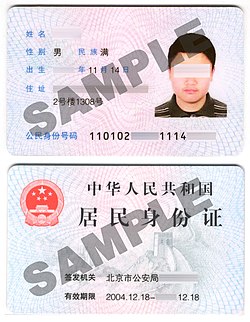| Revision as of 11:06, 9 April 2009 editBenlisquare (talk | contribs)Autopatrolled, Extended confirmed users, File movers, Pending changes reviewers, Rollbackers48,193 edits →Contents← Previous edit | Revision as of 13:41, 9 April 2009 edit undoBenlisquare (talk | contribs)Autopatrolled, Extended confirmed users, File movers, Pending changes reviewers, Rollbackers48,193 editsNo edit summaryNext edit → | ||
| Line 3: | Line 3: | ||
| '''TITLE:''' Junmin Shenfenzheng | '''TITLE:''' Junmin Shenfenzheng | ||
| ]第二代居民身份证]] | ] | ||
| '''Junmin Shenfenzheng''' (Chinese: 居民身份证; ]: Jūmín Shēnfènzhèng) is the official form of ] in the ]. | '''Junmin Shenfenzheng''' (Chinese: 居民身份证; ]: Jūmín Shēnfènzhèng) is the official form of ] in the ]. | ||
Revision as of 13:41, 9 April 2009
This is a draft copy. Please be patient in awaiting the final copy. Thank you.
TITLE: Junmin Shenfenzheng

Junmin Shenfenzheng (Chinese: 居民身份证; Hanyu Pinyin: Jūmín Shēnfènzhèng) is the official form of personal identification in the People's Republic of China.
History
Contents
The identity card consists basic information regarding the individual, such as full name, date of birth, ethnicity. Information stored in the identity database documents information such as work history, educational background, religion, ethnicity, police record, medical insurance status, landlord's phone number and personal reproductive history.
Identity card number
Identity law
Usage of identification
Citizens within the People's Republic of China must carry identification at all times, compulsory from the age of 16. The identity card is the only acceptable legal document to obtain resident permit, employment, open bank accounts, obtain passport, driver licence, application for tertiary education and technical colleges, security checkpoints in domestic terminals of Chinese airports.
Anti-counterfeiting measures
